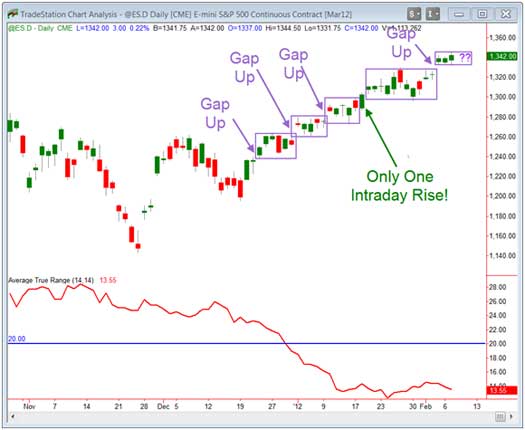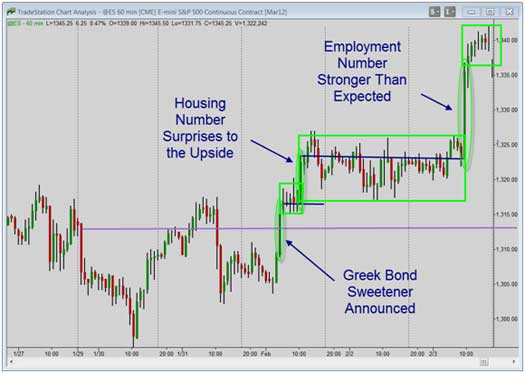Tharp's Thoughts Weekly Newsletter (View On-Line)
-
Article How the Super Trader Program is Evolving Van K. Tharp, Ph.D.
-
-
Trading Tip Pop and Chop—The Markets’ New Normal by D.R. Barton, Jr.
-
Offer No Shipping Cost on These Downloadable Items
-
Fun Check out Photos from Dinner and More Poker with Van!
$700 Discounts Expire Next Week, February 15th, on Two Sydney Workshops

How the Super Trader Program is Evolving
by Van K. Tharp, Ph.D.
I’m always asking myself how I can improve the Super Trader program. And I have found that when I keep asking the question, I keep getting answers. In fact, since it first began in the mid-1990s, the Super Trader Program has evolved considerably, and we have just made more significant changes.
Many of you have heard me say that it requires just as much work to become a good trader as it does to become proficient at any other profession. For example, opening an account with a broker without doing the preparatory work is a little like walking off the street and into a hospital to perform brain surgery. With little preparation, your patient probably would die from that surgery. Likewise, your brokerage account is likely to expire if you trade it without the appropriate education. Perhaps you’ve had an experience of your account dying?
The proper preparatory work to trade is a significant task. One of our current Super Traders estimated that it would require about 5,000 hours of work for him to finish the Super Trader program. Averaging about 32 hours a week, he managed to complete his psychological work, about half the program, in about 10 months. Another Super Trader averaged 20 hours per week on Super Trader assignments and managed to get a psychological completion in about a year.
Super Trader Plaques
We have two Super Trader award plaques in the office. One is for Super Trader psychological completions. You get your name on that when you finish two assignments: completion of 16 psychological lessons that go with the Peak Performance Home Study Course and documentation of five major transformations that have happened during your Super Trader program. Most people who get that far tell us that the transformations alone are worth the price of the program. But then they run into a big barrier—their two year program runs out, and they need to decide to (or decide not to) get an extension.
While I’m happy that a lot of people have completed the psychological portion of the program, I’m looking for all of them to earn a spot on the Super Trader Graduates plaque. In order to earn a spot on that second plaque, Super Traders must create a trading business plan; develop three systems that work in different market types; and prove they can trade those systems at 95% efficiency (i.e., no more than one mistake in 20 trades). People in the program developed those criteria for graduation, not me. The graduation requirement is a tall order and, so far, only four people have achieved that status.
Completing the entire program takes significant time and effort. So what does that mean for someone who works full time, has a family, and cannot put in an additional 20-30 hours per week? Well, their chance of becoming a Super Trader Graduate in two years is slim. It takes a lot of work to become a Super Trader graduate, and two years probably isn’t enough time for most people. In fact, I’ve had people who have extended their program at least two more years, and they still have not graduated.
A much more common scenario has been that people get a psychological completion in their two years and then stop their Super Trader work—at least under my supervision. Even R.J. Hixson, who works at my office, falls into that camp. He earned a psychological completion and completed his business plan during his two years in the program. That was in 2008, however, and he hasn’t yet graduated. You can read more from his perspective in a recent project marathon article, but, in a nutshell, he has not utilized my coaching.
Expanding the Program
Due to these and other factors, we are expanding the Super Trader program. We have now split the program into two parts; part one is the psychological component. While the overall timeframe for completion of the program has increased, the effective cost has decreased. Now, Super Traders are given three years to complete Super Trader I for a cost of $35,000. Most of the Super Traders in the former structure earned a psychological completion in two years, which cost $50,000, so you can already see how the change benefits you.
When you complete Super Trader I, your name goes on the first plaque. Then, you can move on to Super Trader II. This phase again lasts three years and costs $30,000. (So now, you have up to six years to accomplish both phases of the new program). During Super Trader II, you complete your business plan, develop three systems designed for at least three different market types, and prove that you can trade those systems at 95% efficiency. Completing those tasks gets your name on the second plaque.
Out with the Old, In with the New
The old Super Trader program cost $50,000, which was split into four payments spread six months apart. The new program at full cost is $65,000, which is also split into four payments. But now, the first two payments are made in Super Trader I, and the second two payments are made in Super Trader II - which could be as much as two years later.
The old two-year program could be extended for $10,000 per year. If you took six years to graduate, the total cost for the program would have been $90,000 ($50K + (4 × $10K per year)). At six years long by design, the new program costs $65,000, so there’s a $25,000 savings up front. But there are ways to save even more.
With the program’s new structure, it’s possible to graduate in four years at a significant savings. For those who can put in the time to earn their psychological completion within one year, the total program will cost only $45,000. So the old program used to cost $50,000 for two years. The new program costs $45,000 for four years. “Which is the better deal for you?”
Here is how the discount works. If you finish Super Trader I in a year, as some people do, you get a $20,000 discount on Super Trader II (i.e., you pay $45,000 for the whole program, which can still take up to four years). The longer it takes you to complete Super Trader I, the smaller the discount becomes for Super Trader II. You get a $15,000 discount if you take 18 months to complete Super Trader I, and a $10,000 discount if you take two years to complete it. But even with the smallest discount, you pay $55,000 for five years versus $50,000 for two.
Entry Requirements
We still have the normal qualifications for the program. First, since Super Trader I is all about working on yourself, I need to believe that you are interested and excited to do that. Thus, you must attend either a Oneness Awakening Workshop or Peak Performance 101 so that I can see how you react to exercises that involve working on yourself. Facing who you are and working on yourself is probably the hardest thing for most people to do. But the rewards of doing so (on your trading, your life, and your happiness) are immense.
Second, I need to know a little about you—especially your commitment. Consequently, there is an application for you to fill out that includes a statement of commitment. Are you willing and committed to make the time to do the work?
Third, the program needs to make sense for you financially. I don’t accept people into the program, if the fee would be a significant burden for them. If you increased your yearly income by 10% after the second year, would that be enough money to make for the program each year. If so, then the program probably makes sense for you.
There are a lot more details on our web site about the new structure for the program and the costs. If you are interested, go to www.vantharp.com/products/super-trader-program.asp
We can take up to seven new people in the program before June, but those slots will fill quickly as we already have several candidates considering joining.
*We call people who are in the program Super Traders, but in reality the term should be reserved for graduates. In this article Super Trader refers to someone who is in the program and Super Trader Graduate refers to someone who has completed both levels of the program.
About the Author: Trading coach, and author, Dr. Van K. Tharp is widely recognized for his best-selling books and his outstanding Peak Performance Home Study program—a highly regarded classic that is suitable for all levels of traders and investors. You can learn more about Van Tharp at www.vantharp.com.
Trading Education
Workshops
A Mid-March Peak Performance 101 Has Been Added in Sydney!
Blueprint for Trading Success
February 24-26
Medina Hotel Sydney AU
|
This is a complete structured program in which you’ll learn strategic, focused steps that will serve you throughout your entire trading career. During these intensive, hands-on three days, you will learn 17 clear and concise tasks to master that will take your trading from ho-hum to visionary. You will leave with a thorough checklist of action steps to guide you to a higher level of performance. More...
$700 Discount Expires Next Week, Feb 15 |
How to Develop a Winning Trading System That Fits You
Feb 28-Mar 1
Medina Hotel Sydney, AU
|
Our job in this workshop is to teach you what you need to know to develop your own system. The material you will learn is not market or time-frame specific. So whether you trade stocks, futures, currencies or gold, etc., or whether you place 50 trades per day or 50 trades per year, you will learn all of the components that work in any system. More...
$700 Discount Expires Next Week, Feb 15 |
Peak Performance 101
March 17-19
Mercure Hotel Sydney AU |
Understand why some people consistently make profits over and over again, while others are erratic and unsuccessful. More importantly, you’ll learn how to overcome self-sabotage and develop rock-solid discipline in your performance in the
markets! More... |
More upcoming workshops in Cary, NC
- March - Mechanical Day and Swing with Ken Long
- March - Discretionary Live Trading with Ken Long
- April - Core Systems that Outperform with Ken Long
- April - Blueprint for Trading Success with Van and RJ
- May - Peak Performance 101 with Van Tharp
- May - Peak Performance 202 with Van and Libby
Click here to see the full workshop schedule and more more info |
Trading Tip
Pop and Chop—The Markets’ New Normal
by D.R. Barton, Jr.
I had never felt so small in my life.
I was at the Washington Redskins training camp visiting my brother Douglas, who was interning in the Redskins’ public relations department. With a family insider, I was able to watch from the actual practice field and eat with the players.
Even though I’m six feet tall (1.8 meters), I felt like a flea standing beside Joe Jacoby in the chow line. Jacoby was a mountain of a man, but he was soft spoken and answered my enthusiastic questions with patience and sincerity, a real gentleman. Standing six feet and seven inches tall (2.0 meters) and weighing 305 pounds (138 kilograms), he was also a physical anomaly.
Back in the early 1980s when Jacoby started playing in the NFL, there were only a handful of players who tipped the scale at 300 pounds. By 1990, every team in the league had a least a couple of players who weighed more than 300 pounds. And by the start of training camp in 2010, the Associated Press stated that an amazing 532 players reported to preseason camp weighing in at 300 pounds or more.
Indeed, 300-pound linemen are the new normal in the NFL.
In the equities markets, there also seems to be a new normal.
For the past six weeks, we’ve had an interesting phenomenon show up—one that I have dubbed the “Pop and Chop.” In this new market movement, the markets make a quick news-based directional move (the “pop”) and then wander in a sideways fashion for days (the “chop”) until another story comes along to provide another “pop.” This is an important enough development that I think we should look at it across a couple of time frames.
A Visual Primer
Let’s take a look at a chart that shows the market’s impressive run-up since the middle of December 2011. During this move, we’ve had essentially zero pullbacks and nothing that looks anything remotely like a correction. Here’s a daily chart of the S&P 500 futures (day session only).

There are three key elements to the chart above (in addition to the lack of pullbacks mentioned earlier):
- In less than seven trading weeks, volatility as measured by Average True Range (ATR) has been cut in half. And this is coming off a very volatile market that maintained ATR readings greater than 25 for four and half straight months! $VIX (the CBOE Volatility Index) has undergone a similar decline.
- During this climb, we’ve jumped from trading box to trading box, much like Nicolas Darvas described almost 60 years ago. After each “pop,” the “chop” has lasted at least five trading days. (As an aside, Darvas first defined trading range boxes which have become associated with his name and hence are called Darvas boxes. Interestingly, he thoroughly describes the boxes in his classic trading book though there is not one single box drawn on a chart; Darvas was a tape reader! He visualized all of the boxes in his mind.)
- Five of the six “pops” from one box to another were driven by news that happened outside of regular trading hours. Only the rise on January 18th happened during regular market hours, driven by a better-than-expected housing number. And that “pop” was aided by some more overnight upward movement!
With that background, let’s drill down one time dimension to an hourly chart and look at last week’s 2% rise in the S&P 500 on a 24-hour per day, 60-minute chart.

Here we can see that 95% of last week’s up move occurred in just three hourly bars! The trading action for Monday and Tuesday chopped a bit lower, and then we got a big up move when Greece promised a higher payout to bond holders in pre-trading hours (US time). Later that morning, after the market opened in the US, the NAHB Housing Market Index was reported much higher than expected, and the market jumped to a new box. In pre-market trading on Friday the 3rd, the strong monthly employment numbers were announced and the market jumped another level only to trade sideways in a tight, 8-point range during regular trading hours until the close for the week.
The equity markets are in a tough-to-trade place. If you happen to be on the right side of the market when news is announced, you get rewarded. If not, you’re subjected to long and tedious, low-volatility trading until the next piece of news catches the market’s fancy.
One thing we can be sure about: this volatility contraction will end with a volatility expansion. But like other orderly bull runs before this one, don’t be surprised if it goes on for longer and takes prices higher than many pundits expect. Regardless, be sure to protect yourself—downside volatility expansions are explosive and eat up lots of gains in short periods of time. We only need to look back to August 2011, the flash crash of May 2010, and the bursting of the real estate bubble leading to the epic drop of 2007–2008 to see how the last major volatility contractions ended.
As always, I’d love to hear your comments and feedback. Send them to drbarton “at” vantharp.com.
Great Trading,
D. R.
Offer
No Shipping Costs on These Downloadable Items
The Intro to Position Sizing Strategies E-course $149
The Position Sizing Trading Simulation Game $195
The Investment Psychology
Inventory Profile $100
Two Special Reports on Self-Sabotage $19.95 ea
Special Report Does Your System Still Work in Changing Markets? $19.95
Fun
Photos of everyone relaxing after a
few days of hard work in the Peak 101 Workshop.

See More....
Ask Van...
Everything that we do here at the Van Tharp Institute is focused around helping you improve as a trader and investor. Therefore, we love to get your feedback, both positive and negative!
Click here to take our quick, 6-question survey.
Also send comments or ask Van a question by using the form below.
Click Here for Feedback Form »
Back to Top
Contact Us
Email us [email protected]
The Van Tharp Institute does not support spamming in any way, shape or form. This is a subscription based newsletter.
To change your e-mail Address, click here
To stop your subscription look at the very bottom, left corner of this email and click on that link.
How are we doing? Give us your feedback! Click here to take our quick survey.
800-385-4486 * 919-466-0043 * Fax 919-466-0408
SQN® and the System Quality Number® are registered trademarks of the Van Tharp Institute
Back to Top |